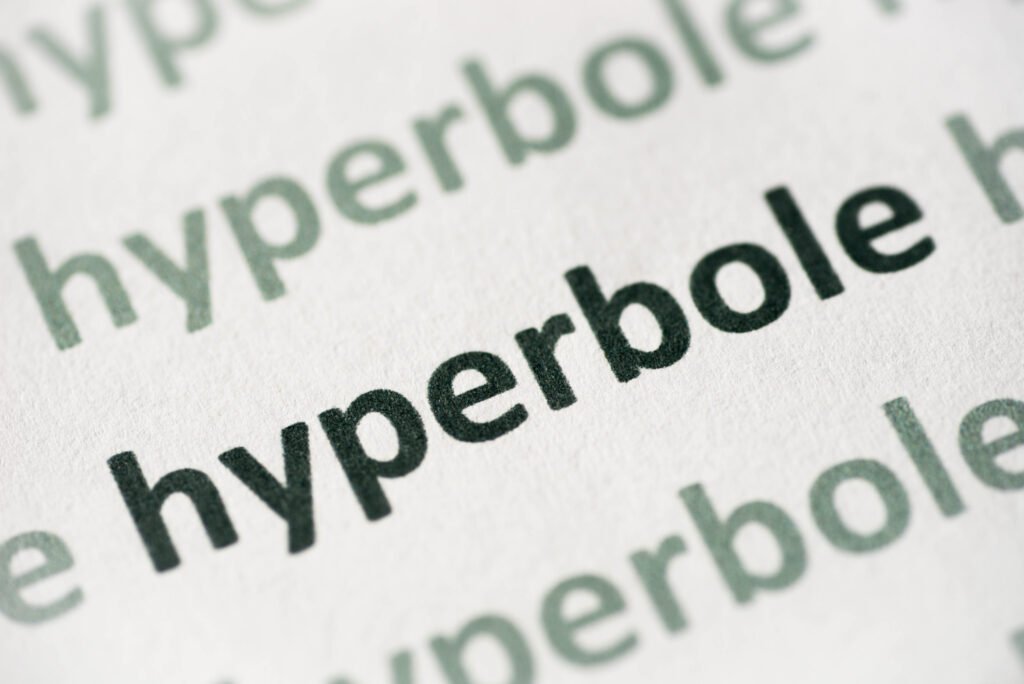
Hyperbole is a rhetorical device and figure of speech that involves deliberate exaggeration for emphasis or effect. It is not meant to be taken literally but to create a strong impression and add intensity to the message. Understanding hyperbole is essential for interpreting and using language creatively and effectively.
Defining Hyperbole
Hyperbole refers to an exaggerated statement or claim that goes beyond what is realistic or possible. It is used to emphasize a point, evoke strong feelings, or create a humorous or dramatic effect. Hyperbole is typical in everyday language, literature, and speeches.
Examples of Hyperbole
- Everyday Conversation: “I’m so hungry I could eat a horse.”
Exaggerates hunger to emphasize how hungry the speaker is. - Literature: “He was as tall as a skyscraper.”
Uses exaggeration to describe someone’s height dramatically. - Advertising: “The best pizza in the universe!”
Emphasizes the quality of the pizza in a playful, exaggerated manner. - Speeches: “I’ve told you a million times not to do that.”
Exaggerates the number of times to stress the importance of the message.
Characteristics of Hyperbole
- Deliberate Exaggeration: The exaggeration is intentional and not meant to be taken literally.
Example: “I’m dying of laughter” means someone finds something extremely funny. - Emphasis and Effect: Used to highlight a point, create a vivid image, or evoke strong emotions.
Example: “This bag weighs a ton” emphasizes that the bag is very heavy. - Creativity: Adds a creative and often humorous or dramatic flair to language.
Example: “He ran faster than the speed of light” creatively emphasizes speed.
Importance of Hyperbole
Hyperbole is important because it:
- Enhances Expression: Adds emphasis and intensity to descriptions and statements.
- Engages the Audience: Captures the listener’s or reader’s attention with dramatic or humorous effects.
- Conveys Strong Emotions: Effectively communicates strong feelings and reactions.
- Adds Creative Flair: Makes language more exciting and entertaining.
Using Hyperbole Effectively
To use hyperbole effectively:
- Match the Context: Ensure the exaggeration is appropriate for the context and audience.
- Maintain Clarity: Make sure the hyperbole is apparent and not confused with literal statements.
- Enhance the Message: Use hyperbole to strengthen the impact of your message without overdoing it.
- Combine with Other Devices: Pair hyperbole with other rhetorical devices for added effect.
Examples of Effective Use of Hyperbole
- In Literature: “The suitcase weighed a thousand pounds.”
Hyperbole emphasizes the heaviness of the suitcase. - In Advertising: “Our ice cream is so good, it will change your life!”
Exaggeration creates excitement and interest in the product. - In Speeches: “The line was endless.”
Emphasizes the length of the line in a memorable way.
Common Pitfalls in Using Hyperbole
- Overuse: Excessive use of hyperbole can make it lose its impact and seem insincere.
Example: Constantly saying, “This is the best ever,” can make the phrase meaningless. - Misinterpretation: If unclear, hyperbole can be taken literally and cause confusion.
Example: Ensure the exaggeration is prominent to avoid misunderstandings. - Inappropriate Contexts: Using hyperbole in serious or formal situations can be seen as unprofessional.
Example: Exaggerating in a business report may undermine credibility.
Hyperbole is a powerful rhetorical device that uses deliberate exaggeration to emphasize points, evoke strong emotions, and add creative flair to language. By understanding and using hyperbole effectively, you can enhance your communication, making it more engaging and impactful. Whether in everyday conversation, literature, advertising, or speeches, hyperbole can add intensity and interest to your message, ensuring it resonates with your audience.






